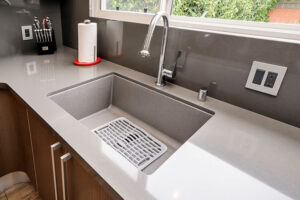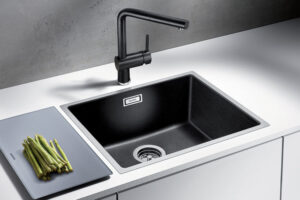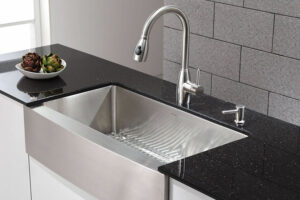When it comes to kitchen remodeling, one of the most crucial decisions you’ll face is choosing the right sink. The sink serves as the central point for everyday tasks such as cooking, cleaning, and food preparation, making it an essential feature in any kitchen. With so many options available, it can be overwhelming to decide which sink is best suited for your needs and kitchen style.
In this guide, we’ll break down the types of sink mounts, highlighting five popular styles: top mount, undermount, flush mount, integrated, and farmhouse. Each style has its own set of advantages and drawbacks, so understanding these differences can help you make a more informed decision when it comes time to choose the perfect sink for your home. Let’s dive into the details of each type of sink to help you navigate your choices.
Exploring the 5 Types of Kitchen Sinks
There are a ton of different decisions that need to be made when remodeling Italian kitchen cabinets, but none perhaps as fundamental as the types of sink mounts you choose. But how to choose is the real question. With so many options available, from kitchen sink mounting types to material, color, number of bowls, and size, it can be overwhelming to pick the right one for your kitchen.
To help you narrow it down, here are the five main types of kitchen sinks—top mount, undermount, flush mount, integrated, and farmhouse—and the pros and cons of each.
Top-mount, drop-in, or self-rimming sink
One of the most popular types of sink mounts is the top-mount or drop-in sink, which is installed from above. A hole is cut into the Custom Countertops based on a template from the sink manufacturer, and the sink is placed from above. The rim of the sink supports all its weight, and then the rim is sealed to the countertop with silicone caulk. Due to the rim around the sink, these are sometimes referred to as rimmed or self-rimming sinks.

Pros
- Easy Installation: No specialized skills are required, making it accessible for most DIYers.
- DIY Friendly: DIYers can typically cut sink openings in laminate and even solid surface countertops.
- Affordable: The overall cost of installation is generally lower compared to other sink types.
Cons
- Debris Collection: The sink’s rim can block water and debris from easily being swept into the sink.
- Extra Cleaning: The rim adds an additional area that needs to be cleaned regularly.
- Aesthetic Concerns: Some homeowners may not prefer the visible separation between the sink and its rim.
If you’re doing a lot of the remodeling work yourself, a top mount sink is a great option because no special skills are needed to install it, as long as the hole in the countertop is cut correctly. However, the rim of the sink means you can’t simply swipe messes right into the sink, and the rim can collect debris and mildew that requires additional cleaning. Also, the look of the top mount sink is somewhat dated.
Undermount sink
If you desire a modern kitchen, an undermount sink is the way to go. The undermount sink is attached to the bottom side of the countertop, supported by the base cabinets. This makes it even more crucial that you choose a really high-quality countertop fabricator to cut a really clean, beautiful edge.
Pros
- Easy Clean-Up: With no rim to obstruct, you can easily sweep water and crumbs into the sink using a sponge.
- Sleek Appearance: The smooth, rimless design offers a modern and appealing look.
- Superior Quality: These sinks are often made from higher-quality materials, offering durability and longevity.
Cons
- Debris Build-Up: While the top stays clean, debris can accumulate underneath where the sink meets the countertop.
- Higher Cost: Undermount sinks typically cost more to purchase and install compared to overmount sinks.
- Size Limitations: Undermount installation may restrict the size options for your sink.
Not only does an undermount sink provide a sleek, modern look, it also makes cleaning up spills and messes really easy, since you can just swipe everything cleanly into the sink. Installation is tricky, so an undermount sink should be installed by a professional.
A flush mount kitchen sink by Blanco.
Flush-mount sink
A flush mount kitchen sink, also known as a tiled-edge sink, sits flush with the countertop, supported by the base cabinets. The sink itself will usually have a couple of extra inches around the bowl. Grout is required between the sink and the countertop, but it does offer a generally smooth surface with the countertop so that spills can be wiped right into the sink.
When considering the top mount vs flush mount sink, the key distinction is how the sink sits relative to the countertop. While a top mount sink sits on top of the countertop, a flush mount sink is installed level with the countertop, providing a seamless look.
Pros
- Seamless Design: The flush-mount sink offers a smooth, uninterrupted surface, making it easy to wipe spills directly into the sink.
- Sleek Aesthetic: The design creates a modern, minimalistic look with no visible grout line, especially with options like the Top Zero model.
- High-Quality Options: High-end flush-mount sinks, like Top Zero, are available, offering durability and an almost vanishing edge.
Cons
- Installation Complexity: Installing a flush-mount sink requires skill, and precise countertop cuts are necessary, making professional installation a good idea.
- Grout Maintenance: Grout is required between the sink and the countertop, which can accumulate dirt and require periodic cleaning.
- Higher Cost: The installation process and higher-quality sinks may increase the overall cost.
For those designing Contemporary Kitchen Cabinets, there are a number of manufacturers making high-quality flush mount sinks, but our new favorite flush mount sink is made by Top Zero because of the seamless, vanishing edge. The edge of the sink, only a few millimeters wide, is mounted perfectly flush with the countertop, and there’s no visible grout line (Top Zero advertises as an undermount sink, but because of the way the sink is installed, for this purposes of this blog post, we’ve classified it as a flush mount sink). Installation takes some skill (and the countertop has to be perfectly cut), so it’s a good idea to have the sink professionally installed. Proper kitchen sink mounts ensure a seamless look and long-lasting durability, making professional installation highly recommended.
Integrated sink
An integrated (or integral) sink is a sink made from the same material as the countertop, with both elements fused together at the factory. Manufacturers like DuPont, with its Corian line, and Samsung, with Staron, specialize in creating these sinks. Unlike other types of kitchen sinks, integrated sinks are seamless and eliminate the need for grout lines, providing a smooth, continuous surface that’s easy to clean. This feature not only simplifies cleanup but also reduces the chances of germs and mildew collecting in corners, which can be a problem with other sinks.

However, integrated sinks are relatively rare and often come at a higher price, mainly because only a few manufacturers, like Corian by DuPont, offer them. They are also more common in bathrooms than in kitchens. If you’re aiming for a stainless steel sink, you’ll need to match it with a stainless steel countertop, as the sink and countertop are made from the same material. Choosing the right kitchen sink mounts is essential to ensure stability and a seamless integration with your countertop.”
Pros
- Seamless Design: Integrated sinks eliminate the visible rim, allowing the countertop to flow smoothly into the sink.
- No Under-Counter Seam: Unlike undermount sinks, integrated sinks don’t have a seam beneath the counter, reducing the chance of debris and mold buildup.
- Aesthetic Appeal: Many homeowners prefer the clean, modern look of integrated sinks.
Cons
- Limited Availability: Integrated sinks are more common in bathrooms and harder to find for kitchens.
- Custom-Order and Expensive: These sinks are typically custom-made, making them a more costly option.
- Difficult to Replace: If the sink is damaged, it cannot be easily replaced; it requires repair instead.
In kitchens with Traditional Kitchen Cabinets, an integrated sink can offer a sleek, modern touch that complements the overall design, creating a unified and elegant look.
Farmhouse sink
Farmhouse sinks, also known as apron sinks, are large, single-basin sinks characterized by their exposed front wall, or apron, which forms both the sink’s front and the front of the counter. Typically made of ceramic, though they can also be found in stainless steel or copper, these sinks are often installed beneath the edge of the countertop, allowing you to easily sweep kitchen debris into the sink. Some farmhouse sinks are also installed in a “country style,” positioned on top of a cabinet or placed on a freestanding table, fixed against the wall, and not surrounded by counters.

While farmhouse sinks have traditionally been popular in farmhouse-style kitchens, the design is making a comeback and is now being featured in more modern kitchens. Additionally, these sinks are also gaining traction in Outdoor Kitchens for their rustic charm and spacious basin, making them a functional choice for cooking and cleanup in outdoor settings.
Pros
- Spacious Basin: These large sinks make it easier to wash bigger items, like casserole dishes and baking pans.
- Closer Reach: The design allows users to stand closer to the sink, reducing strain and fatigue during use.
- Aesthetic Appeal: Many homeowners appreciate the charming “farmhouse” look of an apron sink.
Cons
- Prone to Dripping: The narrow gap between the sink and the floor can lead to more water drips.
- Higher Cost: Apron sinks tend to be more expensive compared to other types of kitchen sinks.
As with other types of sink mounts, farmhouse sinks do require some maintenance, particularly around the small grout line between the sink and countertop that may need periodic cleaning. Despite this, their aesthetic appeal and practicality, especially in larger kitchens, have made them a beloved choice among homeowners.
How to choose the kitchen sink that’s right for you
When selecting a kitchen sink, there are several important factors to consider to ensure that it suits your needs, lifestyle, and kitchen style. Here’s a breakdown of the key elements to keep in mind when learning how to choose a kitchen sink.
Budget
While budget isn’t always a determining factor in choosing a style of sink—since you can find various kitchen sinks in different price ranges—it can still influence your choice. The amount you cook, the type of cooking you do, and whether you plan to install the sink yourself are all important considerations. If you’re doing a DIY installation, you may want to consider a sink that’s easier to install. On the other hand, if you plan on hiring professionals, you may opt for a higher-end sink that offers durability and aesthetic appeal.
Size
The size of the sink should correspond to your kitchen’s layout and your specific needs. Larger sinks are great for people who cook often or handle large pots, pans, and baking dishes. If you entertain frequently or have an active kitchen, you might prefer a deep, single-basin sink. On the other hand, smaller kitchens might benefit from a more compact design that saves counter space. Always measure your space before making a choice to ensure the sink fits properly within your kitchen layout.
Material
The material of your sink plays a major role in its longevity, maintenance, and overall look. Here are some material options to consider:
- Stainless Steel: Best suited for kitchens with granite countertops, stainless steel is durable, heat-resistant, and easy to clean.
- Porcelain: Known for being easy to maintain and clean, porcelain sinks are often a favorite in traditional-style kitchens.
- Cast Iron: While highly durable, cast iron sinks are also expensive and have a unique aesthetic that might not fit with every kitchen style.
- Copper: This material offers a one-of-a-kind aesthetic but tends to be less durable and can be expensive.
- Stone or Fireclay: Perfect for those who want heat resistance, easy maintenance, and a long-lasting material. These options are highly durable and visually striking.
Match the sink to your kitchen style
Choosing the right sink means matching it with the overall style of your kitchen.Conversely, modern kitchens might benefit from the sleek lines of an undermount sink. For those with an outdoor cooking area like a Trevi Outdoor Kitchen, consider a sink designed to withstand the elements while complementing the outdoor aesthetic. Think about the existing décor, your cabinetry style, and your personal preferences. A well-chosen sink will not only function beautifully but also enhance the aesthetic of your kitchen.
Consider your usage
Different types of sink mounts are designed for various tasks. If you do a lot of cooking or have a large family, a deep, large basin sink might be best for you. A dual-basin sink might suit those who need a separate space for washing dishes and prepping food. Think about how much you cook, the size of your cookware, and your daily kitchen activities when selecting your sink type.
Choosing the right sink for your kitchen is a significant decision, as it will serve as both a functional workhorse and a key design element in your space. Keep your budget, size preferences, material choices, and kitchen style in mind, and you’re sure to find the perfect sink that will stand the test of time.
Conclusion
When remodeling your kitchen, the types of sink mounts you consider will play a crucial role in both the functionality and aesthetic of the space. Each sink style—whether it’s the classic top mount, the sleek undermount, the seamless flush mount, the integrated sink, or the stylish farmhouse sink—offers unique benefits and potential drawbacks. As you explore the various options, it’s important to weigh the pros and cons of each to ensure the sink aligns with your cooking habits, design preferences, and installation plans.
When learning how to choose a kitchen sink, consider factors like your cooking routine, the overall style of your kitchen, and whether you plan to tackle the installation yourself. No matter which sink style you choose, it should complement your kitchen’s layout and enhance your daily experience in the heart of your home.



